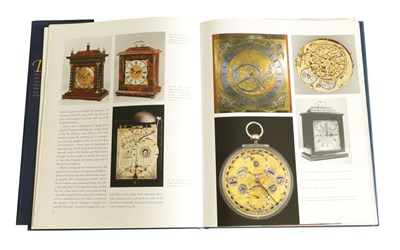7th Jan, 2022 14:00
The Fine Clock Sale
54
THOMAS TOMPION, LONDINI. AN IMPORTANT AND RARE PRE NUMBERED CHARLES II FIGURED WALNUT DUTCH STRIKING BRACKET CLOCK
THOMAS TOMPION, LONDINI. AN IMPORTANT AND RARE PRE NUMBERED CHARLES II FIGURED WALNUT DUTCH STRIKING BRACKET CLOCK the case raised on four bun feet beneath a shallow caddy top surmounted by a hinged brass foliate hoop handle above a glazed square door enclosing a 6 3/4" gilt brass dial with winged cherub head spandrels and silvered engraved chapter ring featuring typical half-hour 'cross' divisions enclosing a matted centre with calendar aperture below the XII fronting a double fusee movement with six latched finned pillars and verge escapement Dutch striking on two bells with a large outside countwheel and finely engraved signed backplate within a wheatear border. This clock is featured and illustrated in 'THOMAS TOMPION, at the Dial and Three Crowns' by Jeremy Evans.
32cm high not including handle
This is the appraisal
This is an attractive and very rare clock of particular historical significance. It is placed in the short period before Tompion was able to expand his own workshop production and one of a small series of only 3 surviving examples known to have been made at this period for Tompion and retailed by him. The other two known Tompion clocks from this group are both ebony.
Conclusions
The case, although now rather pleasing, was probably made to a budget, indigenous walnut being a great deal cheaper at the time than imported ebony. The walnut mouldings are laid on pine, which is standard at this period on furniture. The movement and backplate engraving is extremely interesting and the work is similar to a small number of clocks by different makers of the period. This clock is representative of a short time in Tompions earlier working life when he was under particular pressure and demand outstripped supply. At this time (latter 1670's) he was working with only one apprentice and had some of the most important early commissions that were to enhance his reputation and enable him to expand his output. These included 'the Kings watch' with Hooke for Charles Il and the timepieces for the new Observatory at Greenwich. It was for these reasons that he was obliged to buy-in from another maker. It has not been possible to attribute the movement of this clock to one particular maker. There are similarities which may point to Henry Jones, but equally a small number of other makers, John Clowes, Jeremy Gregory and Charles Gretton (although his using rack striking), were making clocks of a similar nature. Any of these could be the maker of this clock. Although trade between workshops is well known (Tompion movement in The British Museum signed Quare), there is a lack of firm documentary evidence, and it is only by comparison of distinct workshop "patterns' and particular styles of striking and repeating systems that one is able to attribute with any degree of certainty. In this case it seems possible, for simple logistical reasons that the actual maker of this clock may have been from the Fleet Street area. The exception to this was Gregory, who was working near the Royal Exchange. from Jeremy Evans, Curator at the British Museum.
Thomas Tompion, born in 1639 and died in 1713 was one of England's greatest clockmakers. He is buried in Westminster abbey and a full history can be found in Symonds' book Thomas Tompion His Life And Work'
Sold
Auction: The Fine Clock Sale, 7th Jan, 2022
Sell a similar item
Please complete the form below. To help us with your valuation, please attach at least 1 clear photograph of your item.






































